Nano and Battery Anode:A Review
要約
容量を増やすなど、アノードの特性を改善することは、バッテリーの性能を改善するための基本的な必需品の1つです。この論文では、合金性能を備えた大容量アノードを紹介し、次にこれらのアノードの断片化の問題とサイクル寿命中のその影響について述べます。次に、断片化の問題を解決し、特性を改善する上で、サイズをナノスケールに縮小することの効果について説明し、最後に、さまざまな形態のナノ材料を調べます。本論文では、ナノスケールの現象であるアノードの電極還元について述べた。合金アノードに対するこの現象の悪影響が表現され、適切なナノ構造を準備することによってこれらの悪影響を排除する方法が議論されます。また、酸化チタンファミリーのアノードを紹介し、これらのアノードの性能向上に対するナノの効果を表現し、最後に、ナノに特有の準容量性挙動を紹介します。最後に、3番目のタイプのアノードである交換アノードが導入され、それらの機能が表現されます。これらのアノードの可逆性に対するNanoの影響について説明します。これらの電極に対するナノテクノロジーの利点について説明します。この論文では、ナノテクノロジーは、浸透距離の短縮や応力の変調などの一般的な効果に加えて、容量性準容量、貯蔵メカニズムの変化など、このタイプのアノードに他の興味深い効果を生み出すこともわかっています。ボリュームの変更。
はじめに
グラファイトは、層間の距離が約35.3Åの層状構造の炭素材料であり、リチウム原子を配置するために層間に適切なスペースがあります[1,2,3,4]。充電中、リチウムイオンはアノードで還元され、リチウム原子に変換されます。リチウム原子は、グラファイト層間に配置されます。リチウムの到着後、プレート間の距離は3.5Åに達します[5,6,7,8,9,10]。放電中、リチウム原子は酸化されてリチウムイオンになり、電解質を通ってカソードに輸送されます。グラファイトにリチウム原子が挿入されているため(充電時)、これらの材料はインターカレーションアノードと呼ばれます[6、7、8、9、10、11、12、13、14]。グラファイトの図1によると、6個の炭素原子ごとに最大1個のリチウム原子を格納できます[5]。容量はリチウムの貯蔵量に直接関係するため、グラファイトはリチウム金属アノードよりも容量が低くなりますが、前述のように、樹枝状の成長の問題がないため、商用アノードとして使用されます。この記事および今後の記事では、アノードとカソードはアノードとカソードの活性物質を意味することに注意してください[6、7、8]。グラファイトの容量が少ないため、容量の大きいアノードが必要です[15、16、17、18]。大量のリチウム原子を貯蔵できるアノードのグループは、金属または半導体で作られた合金タイプのアノードです。これらのアノードの機能は、金属または半導体と合金を形成し、それによってリチウム原子を貯蔵することです[19、20、21]。このタイプの材料では、6個の炭素原子ごとに1つのリチウム原子しか格納されないグラファイトと比較して、金属原子ごとに複数のリチウム原子を格納できます[9、10、11]。これらのアノードの中で最も重要なものは、シリコンとアンチモンです。シリコンの場合、容量は約4000 mAh / gであり、スズの場合、容量が約350 mAh / gのグラファイトと比較して、前述の容量は900 mAh / gです。図2によると、合金アノードの中で、シリコンは最大の体積と重量の容量を持ち、自然界に豊富に見られ、電子産業全体がシリコンに基づいています。したがって、図2に示すように、シリコンは合金アノードの中で最も重要です[12、13、14、15]。したがって、この記事のほとんどの資料はシリコンに関するものですが、言及されている原理は他の合金アノードに一般化することができます。活性アノード材料、理論容量、利点、および研究結果を表1に示します。
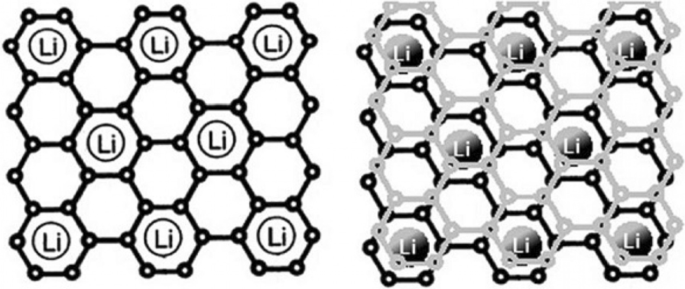
リチウムがグラファイトにどのように貯蔵されているかを示します。 6個の炭素原子ごとに1個のリチウム原子が格納されます[12]
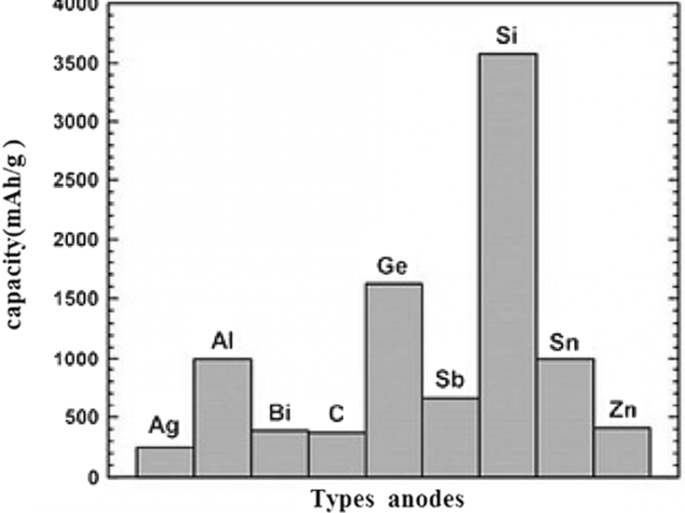
容量のあるアノードの種類[13,14,15]
合金アノードの問題
これらのアノードでは、リチウムの貯蔵と放出には、図3に示すように、初期体積の最大400%に達する可能性のある大きな体積変化が伴います。作業サイクル中、体積変化によって引き起こされる応力により、活性物質の粉砕現象が発生します[7、10、39、40]。断片化により、活物質自体の間、活性導電性添加剤間、および活性収集活性物質間の接続が切断されます[18、19、20]。この現象が発生すると、活性物質は電気的に分離されます。したがって、酸化反応を実行するために電子移動は起こりません。したがって、大量の有効成分は未使用のままで容量に関与せず、最終的には作業サイクル中に容量が急激に低下します[21、41、42]。図3は、破砕現象を示しています。残念ながら、図3はアノード電極の全体的な構造を示していません。実際、従来の電極では、活物質のミクロン粒子がバインダーや炭素伝導性材料などとともに使用されています[43、44、45、46]。上記の電子接続が切断された場合、これは切断されます。図4は、10ミクロンのシリコン粒子の充電曲線と放電曲線を示しています。最初の放電でも容量はわずか800mAh / gであることがわかります(最初の4000充電と比較して)。一方、グラファイトでは、容量は作業サイクルごとにわずか0.03しか減少しません。これらのアノードは、グラファイトよりも高い電圧を持っています(前述の式によると、アノード電圧が高いほど、バッテリー電圧は低くなります)[10、21、39]。たとえば、シリコンの電圧はリチウムより0.3〜0.4高く、グラファイトでは電圧はリチウムより約0.05 V高くなりますが、シリコンやその他の合金アノードは容量が大きいため、電圧に大きな影響はありません。エネルギーはグラファイトよりも大幅に高くなっています。
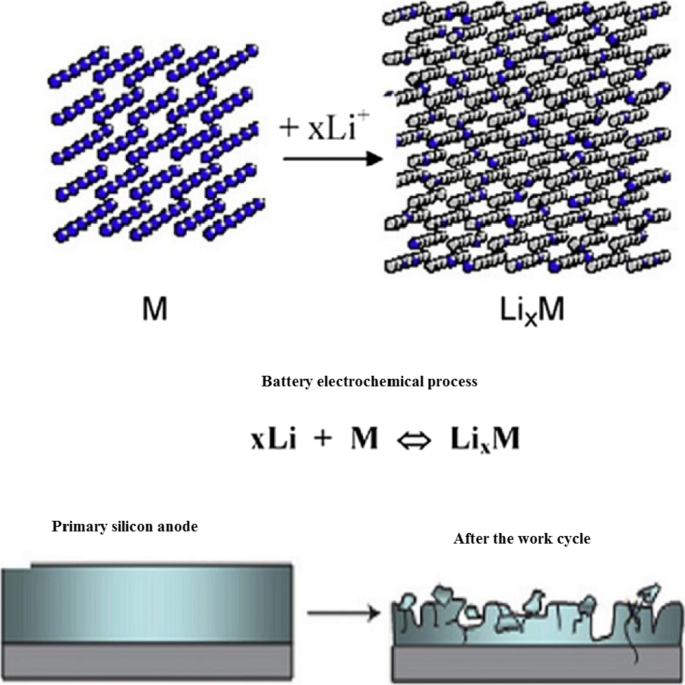
電気接続の粉砕と切断[10]
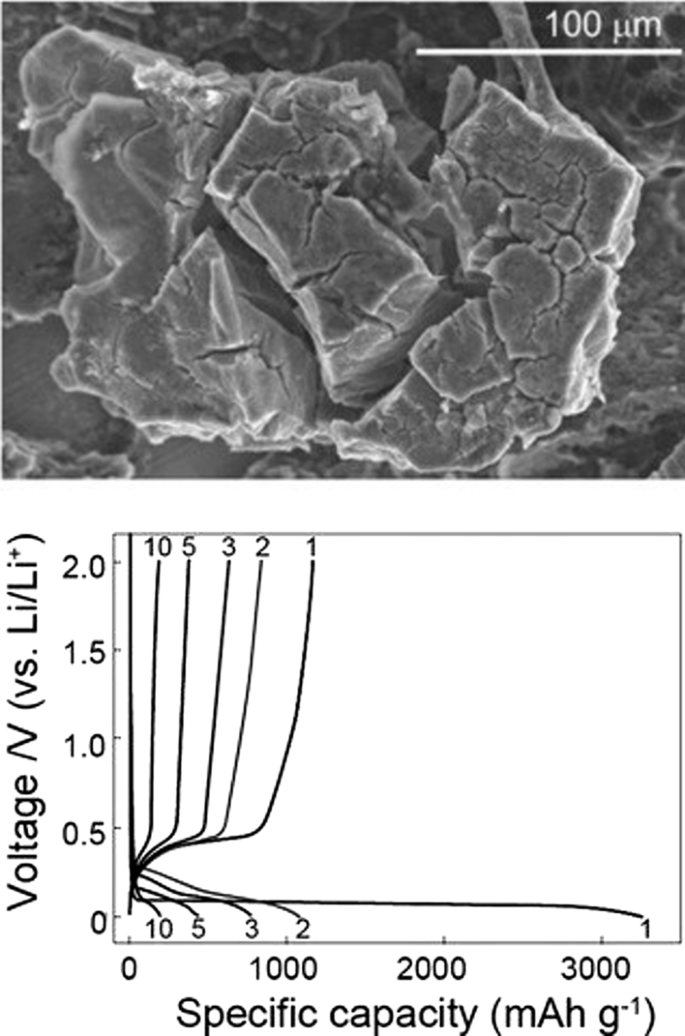
10ミクロンのシリコン粒子の充電と放電の図[17]
ナノテクノロジーソリューション
シュレッダー現象をなんらかの方法で防ぐことができれば、バッテリーの性能を向上させることができます。研究によると、シリコンの寸法がナノメートルの範囲(150 nm未満)に達すると、破砕現象は発生しなくなります[47、48、49、50]。図5は、リチウムイオン化中のシリコンナノ粒子のTEM画像を示しています。これらの2つの粒子は、リチウムの侵入によって体積が変化しますが、応力下では壊れません[7、18、40]。これは、シリコンの並外れた容量を利用するためには、必然的にナノスケールに行かなければならないことを示しています[51,52,53]。ナノ粒子を使用すると、断片化の問題は解決されますが、通常は電子供給に接続されません。そのため、研究者たちは初めて、図6(SEM画像)に示すように、集電体上に垂直に成長したシリコンナノワイヤーを使用しました。このようにして、大きな応力を発生させることなくデューティサイクル中に各ナノワイヤの体積を変化させるのに十分なスペースがナノワイヤ間にあるため、破砕の問題を解決できます。各ナノワイヤの直径も限界寸法よりも小さくなります[19 、20、21、22、30、54、55、56]。知られているように、合金化(リチウムの侵入)後、ナノワイヤの幅が広がり、側壁にテクスチャが生じ、大きな体積変化があったものの、断片化は発生しませんでした[57]。ナノワイヤでは、電子移動(集電体と活性物質間の通信)がナノワイヤの長さ全体で行われます。電子移動が良好であるため、シリコン活物質の全容量を使用することができます[31、32、35、36、37]。ナノワイヤは、バルク材料よりも電解質結合の季節が長くなります[41、42、43]。酸化反応は電極と電解質の界面を介して行われるため、反応の速度も速くなります。一方、ナノワイヤは、イオンが長距離を移動しなければならないバルク材料に比べて寸法が小さいため、横方向の寸法を介したイオンの移動が容易です。イオン移動(電子移動に加えて)はリチウム電池のアノード電極とカソード電極の両方の電位損失(濃度分極)であるため、イオン移動と酸化反応が速くなると、電力とエネルギーが増加します。この分極は、侵入距離とともに減少します。減少し、エネルギー密度が向上します[44,45,46]。最後に、シリコンは半導体であるため、メタロイドであるグラファイトよりも電子伝導性が低くなります[33、38、58]。
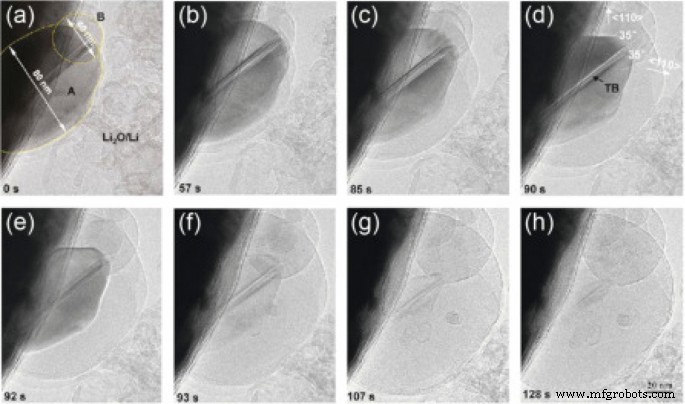
リチウムイオン化中のシリコンナノ粒子のTEM画像は a から進行しました 〜 h それぞれリチウムイオン化[19]
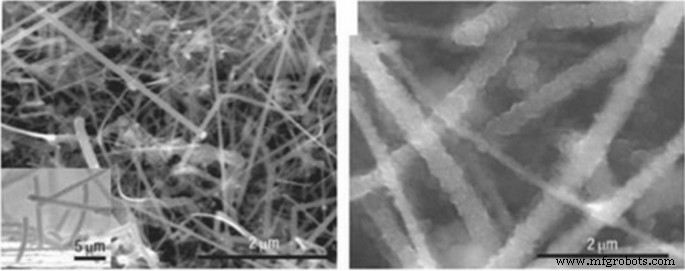
リチウム中のシリコンナノ粒子のSEM画像[20]
さまざまなナノ形態
ナノワイヤの代わりにシリコンナノチューブを使用する方がより効果的であることが示されています。ナノチューブでは、内壁と外壁の両側の体積変化に必要なスペースが提供されます[34、59、60、61]。さらに、ナノチューブは通常ナノワイヤよりも細いため、送信機の方が優れています。シリコンは半導体であり、デューティサイクル中は応力によりアモルファスであるため、デューティサイクル中は電子的にうまく伝導しません[47、48、54]。その結果、電子はシリコンのすべての部分をうまく流れるわけではありません。ハイブリッドナノ構造を使用して、この問題を解決することができます。たとえば、コアに導電性材料が含まれているシリコンナノチューブ、またはその逆の場合、導電性コーティングが施されています[62,63,64,65,66]。コーティングされていないシリコンナノワイヤとカーボンコーティングされたシリコンナノワイヤの2つのカテゴリを比較すると、カーボンコーティングされたナノワイヤはかなりの容量を維持していることがわかります。別の解決策は、ナノコンポジットアノードを使用することです[49、50、51]。ストレスモジュレーター(バッファー)の役割でナノコンポジットで最も広く使用されている材料の1つはカーボンです。たとえば、炭素分野のカーボンナノコンポジットは、ストレス問題の解決策の1つです。図7は、スズ-カーボンナノコンポジットを示しています。スズは合金陽極としての有効成分として機能します。このナノコンポジットの炭素は、バッファーと導体の両方として機能し、さまざまな炭素構造に加えて、リチウムをいくらか貯蔵することができます。図7に示すように、スズの容量は炭素が存在するため理論容量(900 mAh / g)を下回っていますが、サイクル寿命は良好です。最大1000の動作サイクルを維持します[52、67、68、69、70]。

カーボン中のスズナノコンポジットのTEM画像とライフサイクル曲線、暗いスズナノ粒子がマークされています[54]
シリコンは他の合金アノードよりもはるかに高い容量を持っていることを考えると、なぜ他の合金アノードが探求されているのかという疑問が読者の心に浮かぶかもしれません[71,72,73]。与えられ、ナノテクノロジーと電池製品のコレクション全体に一般化できる答えは、ナノ材料がさまざまな方法でさまざまな形態(形状)でさまざまな方法で合成されるためです[74、75、76、77、78]。それぞれの合成方法は、価格、品質、安全性、拡張性、環境への影響などの説明とは異なります。たとえば、金属は、単純な方法であるゾルゲル法では調製できません[79,80,81]。シリコンなどの特定の材料でも、ナノファイバーなどの一次元ナノ材料は、大量生産法であるエレクトロスピニングによって、実験室試験の別の方法である高価な化学蒸着法によってナノワイヤーの形で製造することができます。 [22、52、53、54]。ナノワイヤは、シリコンエッチングによって製造することができます。後者の方法では、結晶方向とドーピングを簡単に制御でき、リチウム貯蔵に対するさまざまなドーパントと結晶方向の影響を決定できます[23、82、83、84、85、86、87、88]。特定の形状と組成のナノ材料でさえ、さまざまな方法で使用でき、特定の方法でも、さまざまな反応物をさまざまな温度条件などで使用できます。投資以外の商業化の鍵は、上記の要因を考慮して適切な製造方法を見つけることです。したがって、電池の製造と性能の間には不可分の関係があり、合成方法に関連して利用できる非常に優れた適切な物品があります[30、31 、56、57、89、90、91、92]。一次元のナノ構造(ナノワイヤーとナノチューブ)に加えて、ゼロ次元のナノ構造(ナノ粒子)を使用する努力がなされてきました(優れたナノ粒子はナノワイヤーよりも合成が容易であるため)。ナノ粒子の問題は、一方ではナノ粒子自体を簡単に接続できず、他方ではナノ粒子と導電性および収集材料を簡単に接続できないことです[32、35、36]。たとえば、図8aは、充電中にリチウムを吸収した後、一次ナノ粒子(画像の左側)の体積が増加し、数サイクル後、リチウムがない状態に戻ったときに電子接続を切断することを示しています[3、24、 93,94,95]。アノード(カソードも)を準備する通常の方法では、活性物質(ここではシリコン)の粉末が、導電性カーボン(導電性を向上させるため)およびPDVFバインダー(粒子の結合用)と一緒に使用されます。図8b。図bによると、シリコンナノ粒子は体積が変化するため、別の初期状態に戻った後、ナノ粒子間の電気的接続、炭素導電性材料が失われ、容量が減少します。図cに示す方法で上記の問題を解決するために、応力変調の役割も持つアモルファスシリコンを接着剤として使用してシリコンナノ粒子を結合し、電気接続が中断されなくなり、容量が維持されるようにします[25 、37、38、96、97]。別の方法では、ポリアニリン導電性ポリマーの分野で、変調と電子伝導の両方の役割を持つナノ粒子が調製され、1600 mAh / gの容量を維持しながら、1000の良好なサイクル寿命を持つことが観察されています。それに比べて、PVDFバインダー法は100回の作業サイクルで容量の50%以上を失います。この問題を解決する別の方法は、中空のナノ構造です。この方法では、中空ボリュームを介したリチウムの出入り中に必要な空きスペースが提供されます[26、27、33、58、59]。有限要素法は、同じ体積で、中空構造が作業サイクル中に受ける応力が少ないため、破砕現象に対する耐性が高いことを示しています(図9)。
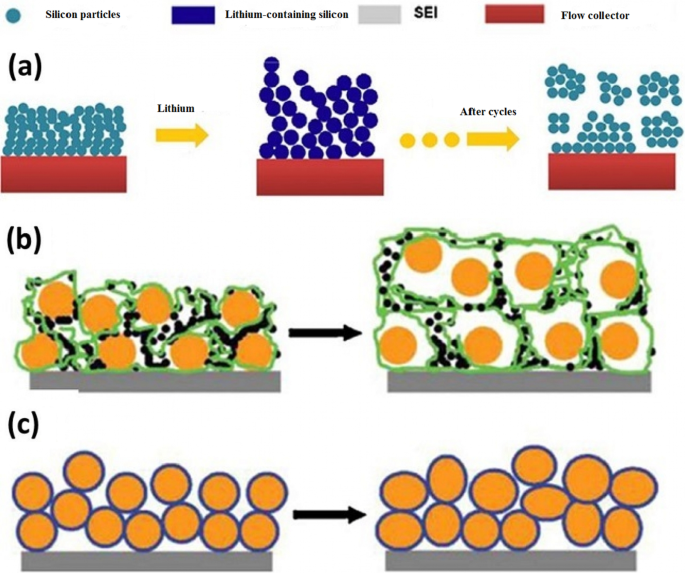
a ナノ粒子と集電体の電気的関係がどのように壊れているかを示します b は別のタイプの切断を示しています。オレンジ色のシリコンナノ粒子と黒色のカーボン、PDVFポリマー鎖は緑色で示されています。 c 変形後もナノ粒子を接着するためにアモルファスシリコン接着剤を使用してください[47]。
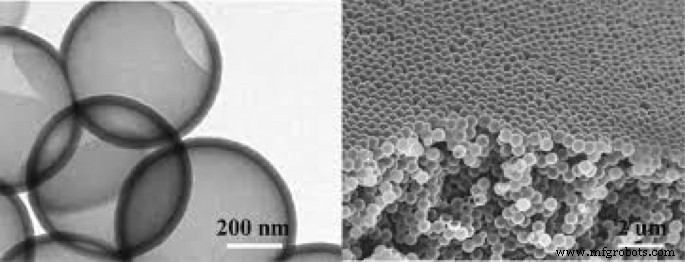
体積変化の問題を解決するための中空ナノ粒子[48]
アノードでの電解質分解
私たちが知っているように、どの物質も潜在的な範囲で安定しており、この範囲内で多かれ少なかれ還元または酸化プロセスを受けます[28、98、99]。そのため、水を分解(電解)して水素と酸素を生成することができます。これらのセルは、電解質セルと呼ばれるガルバニ電池(バッテリー)の反対です。これらのセルでは、バッテリーとは異なり、熱力学的に望ましくない反応を強制するためのエネルギーを与えます[60]。
バッテリーを充電するときは、水を分解するのと同じように、充電器を介してバッテリーにエネルギーを与え、バッテリーで起こった反応を逆転させ、バッテリーを事前放電状態に戻します[100,101,102,103,104]。リチウムイオン電池で使用される有機電解質(水の電気分解など)は、充電器からのエネルギーの結果として変化します。前述のように、リチウムイオン電池では、負極(グラファイトアノード)で、充電中にリチウムイオンの還元が発生します。電解質還元の傾向はリチウムイオンよりも熱力学的に高いため、リチウムイオン還元の代わりに電解質還元が行われます。これにより、グラファイト表面に固体層が形成されます。この固体層はSEI(固体電解質界面)と呼ばれます。この層の組成は複雑で、いくつかの化学物質の混合物です。図10に、このレイヤーの概略図を示します。図からわかるように、この物質の組成にはリチウムイオンと炭素が含まれています。したがって、この層の形成はリチウムの減少を伴い、これにより最初の電荷の容量が減少します[34、61]。この厚さの層は、図10に示すように、ナノメートルの範囲にあります。SEI層自体の形成は、電解質分子が物理的な障壁としてグラファイトアノード表面に到達するのを防ぐため、電解質還元反応の継続を制限します。実際、それは動的阻害剤として機能します(酸化アルミニウムの不動態層のように、酸素が下部のアルミニウムに到達するのを防ぎ、残りのアルミニウムが酸化するのを防ぎます)。一方、電子絶縁体であるため、電子が電解質に到達するのを防ぎます[62,63,64,65]。したがって、電子が電解質分子に到達することも、電解質分子がアノードの電子に向かって移動することもできません。これらは両方とも、電解質を再生させ、自己制限反応を引き起こします。幸いなことに、この層はリチウムイオンを透過し、リチウムイオンはそれを通過してアノード表面に到達し、電子を捕獲して再生することができます[105、106、107、108]。この層は、リチウムイオンがアノードに到達するまでの浸透距離を伸ばすため、バッテリーの電力を削減します[109,110,111]。
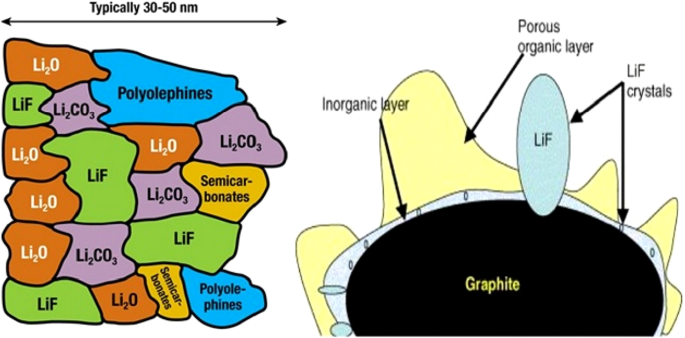
この層のSEI形成と組成の概略図[66]
図11は、アノードとカソードの電位に対する電解質の安定性の範囲を示しています。カソードが電解質の安定範囲よりも高い電位を有する場合、電解質はカソードでおよび充電中に酸化され、またアノードが安定範囲よりも低い電位を有する場合、それはアノードでおよび電解質の充電中に再生される。幸い、図11に示すように、従来のカソードには電解質の不安定性の問題はありませんが、グラファイトとシリコンのアノードでは不安定性があり、SEIが形成されます[66,67,68]。
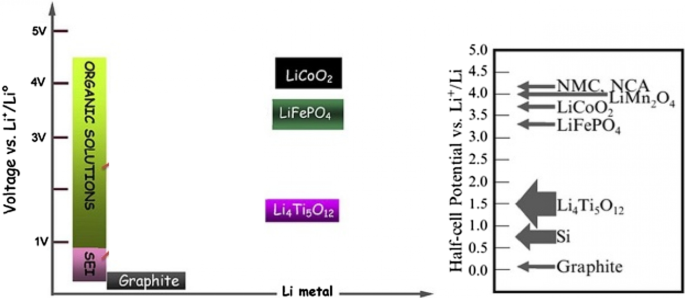
共通のアノードとカソードの電圧、電解質安定電位の範囲、およびSEI形成の電位範囲を示します[67]
シリコンのSEI問題
一般に、リチウム金属に対して1ボルト未満のアノードの場合、電解質は不安定であり、SEIが形成されます。したがって、SEIはシリコンアノードで形成され、リチウムよりも0.3〜0.4高い電位を持ちます[112,113,114,115]。残念ながら、シリコンは体積が変化して分解するため、新しいレベルのシリコンが電解質にさらされ、電子が電解質に到達し、これらの新しい表面に新しいSEIが形成されます。その結果、作業サイクル中は常に容量が減少します。テストはリチウム金属で行われることが多いため、リチウムに対する電圧はすべてのバッテリー製品で測定されるため、これを言う必要があります[69]。シリコンナノ材料では、化学活性が高いため、SEIの形成の影響をさらに受けやすくなります。ナノマテリアルの場合、それらが分解しないのは事実ですが、それらは体積を変化させます。図12によると、このボリュームの変化によりSEIは継続的に成長し、容量や電力の低下など、SEIの成長には不利な点があります。セクションの図13は、ナノマテリアルにおけるSEIの成長の理由をよりよく示しています。図の左側に示すように、充電中に、リチウムを含まない初期状態のナノワイヤ(またはナノ粒子など)の断面がある場合、シリコンはリチウムを含んでいるため、その体積は増加し、電解質が原因です不安定性と同時に、ナノワイヤ上にSEI層が形成されます[116,117,118,119]。放電中、リチウムが出て粒子が収縮しますが、SEIは収縮しません。これにより、SEIは応力下で崩壊します(または、リチウムイオン化下のシリコン拡大の第2段階でも、SEIと粒子の正確な境界が正確に一致しないため、応力が発生してSEIが崩壊します)。したがって、再充電(リチウムイオン化)すると、新しいSEI層が再び形成されます。このサイクルを繰り返すと、継続的なSEIの成長につながり、その成長に問題がありますが、グラファイトでは、SEIはその体積をわずかに変化させないと成長しません。 SEIとシリコンについて述べられていることは、他の合金アノードにも当てはまることに注意する必要があります[70、120、121、122、123]。セクションbに見られるように、この問題はシリコンナノチューブにも存在しますが、シリコンが最初から電解質と接触して電解質の近くでその体積が変化するのを何らかの方法で防ぐことができれば、この問題は解決されます。
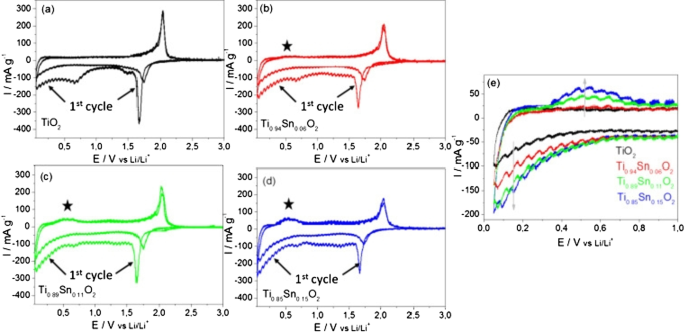
SEIレイヤーの成長方法[19]
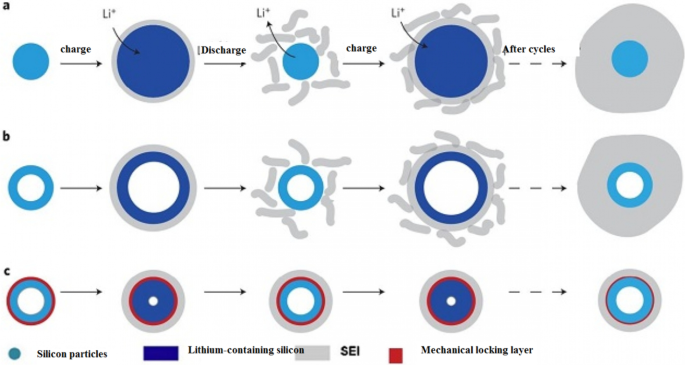
さまざまな条件でのSEIの成長を示しています[20]
ウーら[18]図13cに示すように、機械的ロック層を使用しました。酸化ケイ素でできているこの層は、その機械的強度のためにナノチューブの外容積の変化を防ぎます。したがって、体積を変えることなく安定したSEIが形成されます(グラファイトのような安定したSEI層)。この酸化物層はリチウムイオンの導体であるため、反応に問題はありません。体積変化に必要なスペースも、ナノチューブの内壁を通して提供されます。ですから、つぶれる問題はありません。研究により、電解質がナノチューブに浸透しないことが示されたため、電解質とナノチューブの内壁との間に接触はありません。これらすべての利点により、長いサイクル寿命と優れた電力が提供されます。図14(DWSiNTを使用したこの図に示されている)は、このサンプルの深部放電サイクルの一部を示しています。深放電では、サイクル寿命は常に速く減少します。ただし、900サイクル後も、準備されたサンプルの容量は良好ですが、通常のナノチューブおよびナノワイヤのサンプルは急速に容量を失います。放電)プロットされたサンプルでは、最大6000回のオープンサイクルでも、この比較的高いCレートの後でも、容量がその容量を維持していることを示しています。別の例[19]では、図15cに示すように、コアシェル構造が準備されています。カーボンコーティングは、カーボンコーティング内のシリコンナノ粒子とともに使用されます。カーボンコーティングの厚さは10nmの範囲で、100nmのシリコン粒子が含まれています。カーボンシェルには、図cに示すように、シリコンナノ粒子の体積を簡単に変更できる十分なスペースがあります。一方、シリコンナノ粒子は一点からカーボンシェルに付着しているため、カーボンはグラファイトのようにシリコンではなく電解質の近くにあるため、電子とイオンの遷移が発生し、粉砕することなく安定したSEIが形成されます。シリコンの体積変化はカーボンやカーボンからSEIに伝達されないため、図12の図のように、サイクル寿命が長くなります。前回の記事と図aで見たように、SEIの問題に加えて、シリコンナノ粒子を通常使用すると、体積を変化させるためのシリコンナノ粒子間に空きスペースがないため、粒子間に応力が発生します。それらは体積を変化させますが、この中空構造(図b)を使用すると、粒子間に応力がなくなります。
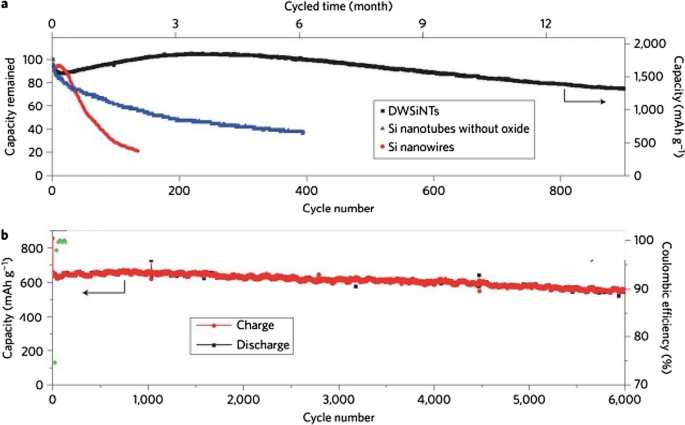
a 酸化物コーティングされた b の黒、青、赤のサイクル寿命の比較 それぞれ酸化物を含まないナノチューブと非酸化物のナノチューブ[21]
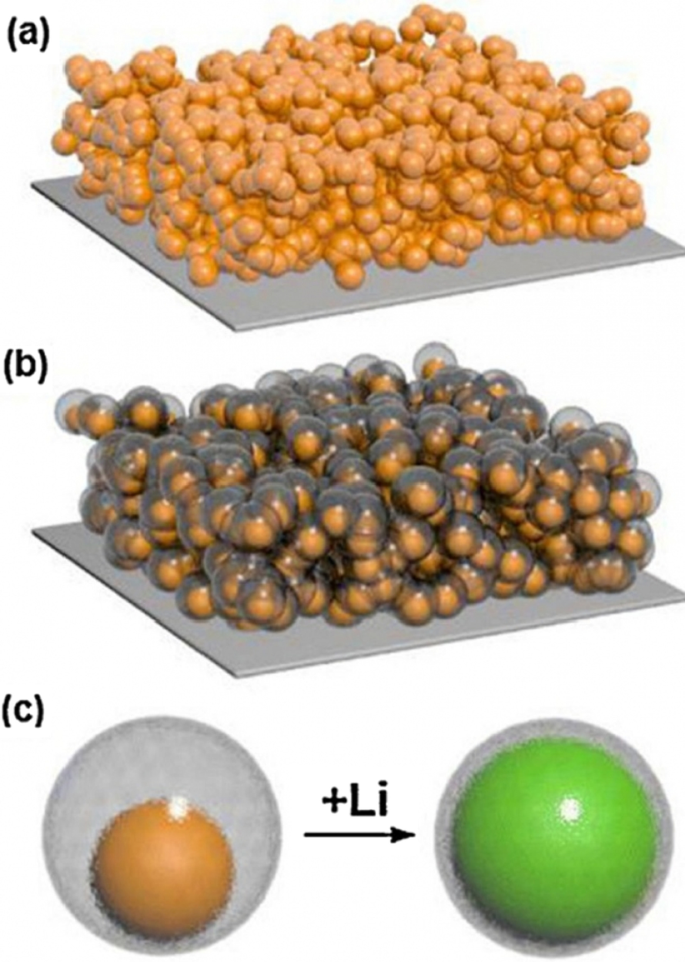
a シリコンナノ粒子製の電極の展示。 b カーボンコーティングと中空構造のシリコンナノ粒子で作られた電極ディスプレイ。 c b で使用されるコアホローシェルの構造 、シリコンは中空炭素の内部にあり、リチウムイオン化中にその体積変化が観察されます[10]
このアノードには、SEIの問題に加えて、図12のサンプルと比較して、他の利点があります。ナノチューブに対するナノ粒子合成の利点の1つ、さらに重要なことに、ナノワイヤーと比較したナノ粒子の使用は、スラリー法との互換性があります。これは、電池に電極を準備する従来の方法です。
LTOアノードの紹介
これまで、2種類のグラファイトアノードと合金(シリコン)アノードについて説明してきました。非常に人気のあるもう1つのアノードは、Li4Ti5O12化合物を含むアノードで、略してLTOと呼ばれます。このアノードは、インターカレーショングラファイトのようなものです[29、124、125、126、127]。図16は、このタイプのアノードの構造と反応を示しています。 LTOアノードの容量は175mAh / gに制限されています(300グラファイトおよび4000シリコンと比較して)。このアノードの電圧も、図17によると、リチウム金属と比較して約1.5 Vです(アノード電圧が低いほど、バッテリー電圧は高くなります)。 This high voltage and low capacity both make this anode have very low energy, but it is still one step ahead of silicon in commercial terms. One of the most important features of this anode is the safety issue, because in electric vehicles there are unpredictable conditions, and the other is the long cycle life, and finally its power [72, 73, 128,129,130].
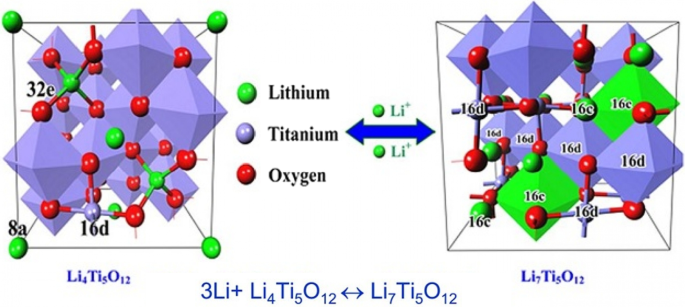
Shows the structure and entry of lithium ion in LTO along with its reaction [74]
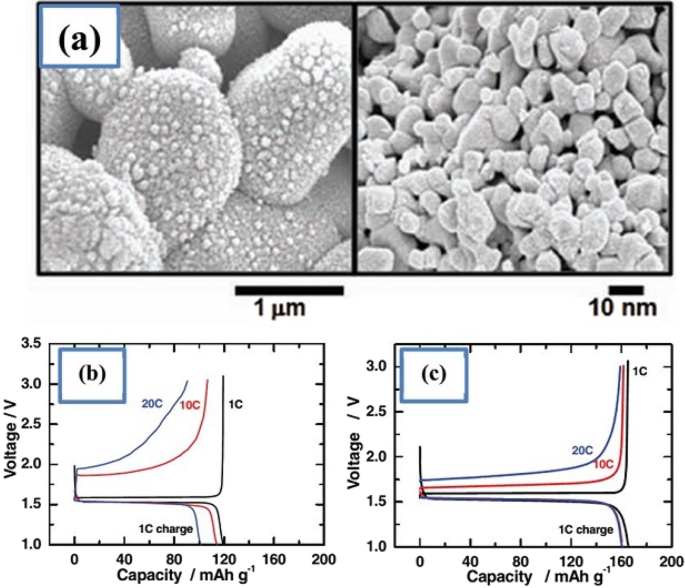
a Displays the nanostructure discussed including Nano primary nanoparticles, b charge–discharge curve for ordinary micro particles, and c for a-shaped particles [74]
Due to the fact that the voltage of this anode is high, it is in the range of electrolyte stability according to Fig. 17, so SEI is not formed. On the other hand, as shown in Fig. 17, there is enough space for lithium ions in this composition and it does not change volume, while even in graphite, some volume change is seen due to the entry and exit of lithium. Unlike the previous two anodes, lithium ions (not lithium atoms) are stored in this anode, and the oxidation reaction is due to the conversion of titanium to 3-valent titanium, not to a change in lithium capacity [28, 74, 75, 131].
This battery, because it has neither SEI nor volume change, maintains the capacity well and has a very long cycle life (more than graphite) of about 20,000 cycles. Because it is an oxide compound and is very safe due to the lack of volume change. Because it does not have SEI, its power is not bad either, only its lithium ion diffusion coefficient is low and its electron conductivity is poor. To solve this problem, they provide LTO nanostructures. Because this anode did not have SEI from the beginning, when it becomes Nano, it does not have the problem of forming more SEI, so it does not have more nanomaterial activity [32, 35,36,37].
It has been observed that nanoparticles cause the LTO anode to charge and discharge within 5 min (12C). To prepare the nanostructure, first titanium oxide nanostructure is prepared and then reacted with a lithium source material when heated. This is also an advantage of LTO, as the preparation of TiO2 nanostructures is very popular. Due to the problem of low volumetric density and agglomeration of nanomaterials, micron secondary particles made from nanoscale primary particles are more useful [33, 38, 58, 59].
Figure 17 shows part an of this nanostructure. As can be seen, from the controlled community of smaller particles measuring 10 nm, larger micron particles are formed. According to the comparison of parts b and c in Fig. 17, it is quite clear that this nanostructure is superior to ordinary micron particles, because it has less capacity and potential (especially in discharge). From this nanostructured anode, a battery is made and it is observed that this battery is superior to the battery with graphite anode both in terms of cycle life and power, which is not given due to the brevity of these curves [75]. The benefits of Nano-LTO have been well documented in many articles, but what makes it stand out is an important discussion of proper engineering of the structure, proper synthesis method, and how to use the conductive material to improve conductivity for further improvement. The future will be talked about. In addition, it is not disputed that nanotechnology is useful for LTO, but many of the phenomena that occur at the nanoscale for LTO are discussed so that some are not fully understood.
Another phenomenon that occurs at the nanoscale is the change in charge–discharge curves for the LTO anode. This anode provides a constant voltage over a wide range of capacities (red box in Fig. 18). When LTO ions are Nano, the constant voltage range decreases until after a critical limit (in the range of a few nanometers) there is no longer a constant voltage range [76].
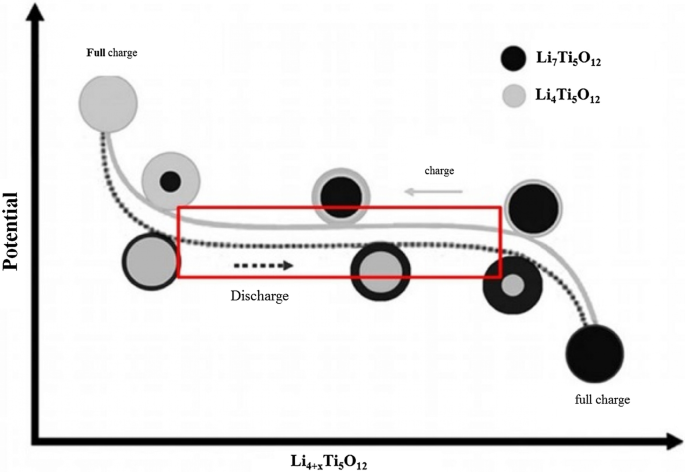
Shows the linear curve range at the LTO anode in the charge–discharge axis [75]
One of the things that happens on the surface is the insertion of more lithium ions into the surface layers. In the surface after insertion, we reach the formula Li8.5 Ti5 O12 , which is 1.5 mol more than the inner layers with the formula Li7 Ti5 O1 , but in the micron material, because the percentage of surface is not high, it shows its effect, but for Nano, because the amount of surface is large, the effects are large. There are several on the charge–discharge curve.
TiO2 Anode
There is also a TiO2 anode from the LTO family. These anodes are easier to synthesize, and because they do not want to react with heat-induced lithium ion precursors, they do not have heat-induced problems such as nanomaterial growth. In addition, according to the chemical formula, titanium oxide has a capacity of twice the amount of 335 mAh/g (LTO). The general response of these anodes is \({\text{TiO}}_{2} + x{\text{Li}}^{ + } + xe^{ - } \leftrightarrow {\text{Li}}_{x} {\text{TiO}}_{2} .\)
TiO2 has four types of phases or crystallographic structures (different atomic arrangements) known as Brocket, Anastasi, Rutile, and (TiO2 (B). The Brocket phase does not matter to the battery. Antara and rutile, which are very popular phases, are important as anodes. Phase (TiO2 (B) performs better than others due to its atomic open space and suitable channel for ion transport, and is the most important [75, 76, 132,133,134,135,136].
If we consider the theoretical capacity based on the chemical formula (one mole of lithium ion per mole of TiO2 ), it is equal to the above value, but based on the phase and position that can be placed according to the lithium ion crystal lattice, different theoretical capacities for different phases have been reported; for example, for anisate, according to network sites, the half-capacity is high, 0.5 mol of lithium ion per mole of TiO2 , 167 mAh/g.
Because all of these phases have poor ionic conductivity, the nanoscale is very effective in increasing both power and capacity. What is interesting is that the nanostructured capacity of Anastasi is more than the theoretical capacity based on the position of the network, but it is definitely less than the theoretical capacity of Formula 334 in all phases. Rutile in micron mode can only store 0.1 mol of lithium ion per grid unit. In rutile, lithium locations are located throughout the network, but the diffusion coefficient in the direction of the c -axis is one order of magnitude greater than that of the ab plate [137,138,139,140,141]. The lithium atom penetrates well in the direction of the c -axis, but must be diffused throughout the space by penetrating the ab plane, and because the diffusion velocity is low in the ab plane, lithium ions accumulate in the c channel, causing a charge repulsive force. Lithium ion positive is generated. This repulsive force prevents more ions from entering the network. As an interesting result of the Nano effect, it has been shown that when the dimensions of rutile become Nano, the capacity reaches 0.8 mol of lithium ion, which has a reversible capacity during different cycles, which reduces the penetration distance and the effect of its quadratic power [142,143,144,145,146]. There is no repulsive force. Figure 19 shows the charge and discharge curves and the cycle life for rutile bulk (micron), commercial rutile micro particles, and rutile nanowires. As can be seen, nanowires show good cyclic longevity and capacity. The shape also confirms that the shape of the nanomaterials also affects the performance of the anode. Morphology such as nanoparticles, nanowires, etc. differ in both capacity and life cycle and power, but the type of morphology alone is not decisive but the geometry of the structure that determines the performance (in the future about the geometry of the structure for all active materials for example, nanowires connected to a current collector, nanowires mixed with graphene, and insulated nanowires each present different results. In addition, there are test conditions and C rate and many other factors [77]. Phase (TiO2 (B), which is newer than other phases, offers the best power and capacity due to its suitable channels for lithium ion transport [147,148,149,150,151]. Figure 20 shows the structure of the penetration site. The capacitance can be significantly increased. This phase offers the best power and capacity among all titanium anodes including LTO, so that by Nano partying it in just 4.5 s, the anode can be charged or discharged with a capacity of 73% of theory. We do not have volume change in this anode either.
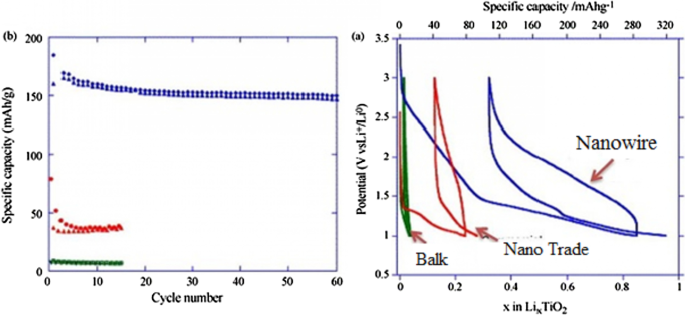
a Charge–discharge curve for the first time, b cycle life [77].
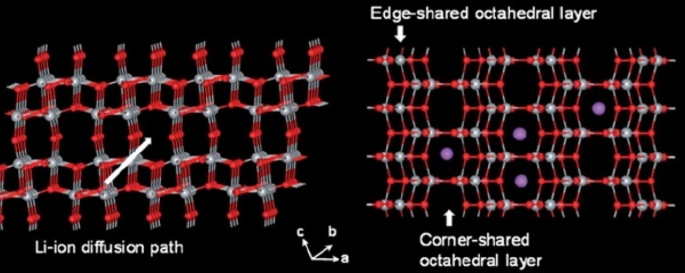
Showing the atomic structure of the phase (TiO2 (B) [77]
Quasi-capacitive Capacity
So far, it has been discussed about the storage capacity of lithium ions in the form of a degree in the nuclear network, and this capacity is improved in the nanoscale due to the reduction of the penetration distance, and so on [152,153,154,155]. But one of the interesting phenomena that occurs for these anodes at the nanoscale is the storage of lithium ions at the surface due to the large surface-to-volume ratio. This type of storage is different from the insert and alloy capacity mentioned so far. This type of storage is very fast because it does not require penetration, and also because it does not create stress and the like, it has the best cycle life and power compared to other lithium storage methods [156,157,158]. Of course, this type of capacity generates less energy. This capacity is discussed in more detail in the topic of super capacitors. The Fig. 21 shows a comparison between the storage capacity of LTO capacity in three different Nano dimensions [78]. According to Fig. 21 in small Nano dimensions, this capacity is significant and decreases significantly with increasing dimensions. It should be noted that capacitive capacitance is not only related to titanium oxide compounds but is also present in many other active substances that are mentioned when introducing them.
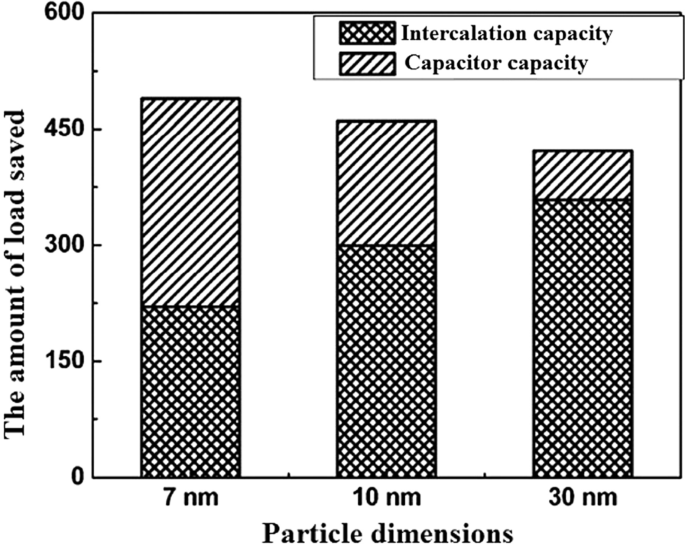
Demonstration of input and super capacitor capacities in titanium oxide [78]
Introduction of Exchange Anodes
So far, we have talked about two types of insert electrodes and alloys. The third type of electrode operation is based on a conversion reaction. Figure 22 shows the mechanism and reaction of this type of electrode. In this form, M (or Me) is an intermediate element that is oxidized, and X is an anion such as oxygen, sulfur, and the like [159,160,161]. The advantage of these anodes is that for every MxXy unit, n lithium ions (n more than one) are involved in the reaction, whereas in the graphite insert anodes we see one lithium ion for every 6 carbon atoms stored in titanium compounds. A maximum of one lithium ion is stored per TiO2 formula unit. But in the exchange anode, for example, for CoO and FeO, the value of n is equal to 2, and in Co3 O4 , the value of n is equal to 8. Figure 23 shows a number of exchangeable oxide anodes with their reaction and capacity [22, 30, 55].
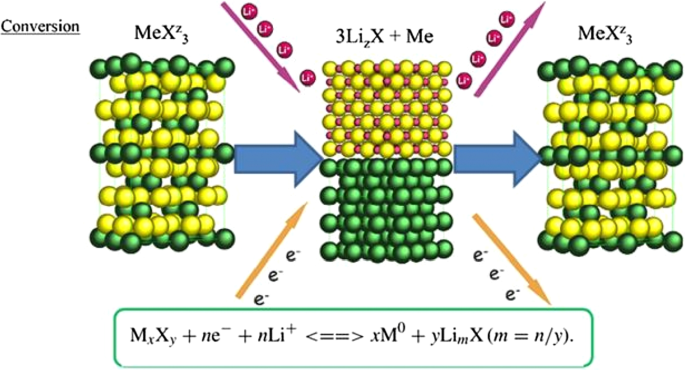
Shows the structure and entry of lithium ion with its reaction [22]

Shows the reaction and capacity of a number of conversion oxide anodes [30, 55]
Exchange Anode Problems
Exchange anodes are very similar to alloy anodes, as alloys have problems with volume change, fragmentation, and SEI formation. In these anodes the ionic and electron conduction is low, and in addition the exchange rate is slow. This low speed leads to high potential during charging and discharging. At these potentials, there is a large difference between the charging and discharging voltages, called hysteresis, which is shown in Fig. 24 with a red arrow. This figure shows that in the first stage of lithium extraction, the anode behavior is significantly different from the next stage of charge and discharge. The hysteresis in this type of anode is up to one volt, while in the graphite and LTO anode it is about 0.2 V. This hysteresis is mostly due to activation polarization [78, 79].
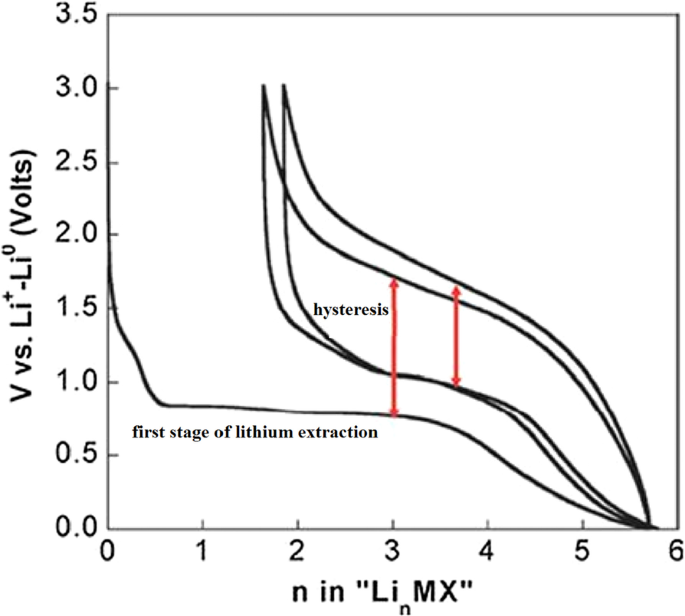
Show charge–discharge curves of exchange anodes [79]
Nano Sizing Effects
Figure 25 shows the lithium ionization behavior (in the test mode, against lithium metal) for anodes made of fine nanoparticles (20 nm) and micro-nanoparticles (500 nm) of iron oxide (SEM) images of these particles in Fig. 26. Available it can be seen that the capacity of the Nano anode is slightly higher. More importantly, it can be seen that the charge–discharge behavior of these two anodes is very different from each other, which is examined in Fig. 26. Figure 26 shows the charge–discharge curves in different cycles as well as the cycle life for the same samples in Fig. 25 to determine the reason for the difference in charge–discharge curves in Fig. 25. Note that instead of capacity, lithium that enters and leaves (which, according to the arguments, represents capacity) is used. In the charge–discharge curves of Fig. 26, lithium ionization continued only up to 1 mol because its purpose was to investigate the behavior in this range of lithium ions. As can be seen, the effective surface mass for the material is only 2 m 2 /g while for the Nano it has an effective surface area of 60 m 2 /g, which indicates how much higher the effective surface area is at the Nano. The difference between Nano and Nano performance is also quite clear. As shown in Fig. 26, the amount of reversible lithium (which can be removed during charging) for Nano is much higher than the corresponding amount for bulk. This shows that the capacity that can be recovered after the initial charge is much better in Nano than in micro. Also, according to the same figure, in the next consecutive charge-discharges, the amount of lithium entering and leaving is less than 0.25 (from 0.75 to 1), while for Nano, the amount of lithium entering and leaving is more than 0.5 (the amount of lithium ion). In the composition it has changed from the range of less than 0.5 ions to 1 ion), according to this, the capacity offered in Nano is much more than bulk. In the micron-sized anode of Fe2 O3 (hematite), before the exchange reaction begins, about 0.1 mol of lithium ion per mole of oxide compound can be stored in the lattice, but above this critical limit, the exchange reaction takes place; on the other hand, when we increase the dimensions of iron oxide particles to 20 nm, the amount of lithium stored in degrees reaches 1 mol, which causes a volume change of only about 1%. Of course, about 0.5 mol is reversible (Fig. 25). In fact, the type of storage mechanism (input, exchange, etc.) changes and the type of mechanism affects the shape of the charge–discharge curve. The above paragraph indicates that when the oxide dimensions enter the Nano field, the storage mechanism is also affected. So far it has been said that Nano makes volume change easier without failure, but here it can be seen that even Nano has reduced the amount of volume change from a few percent for the exchange reaction to one percent for a degree reaction. The reason for this change is the storage mechanism for iron oxide due to thermodynamic problems. The opposite happens for the Co3 O4 anode because it is kinetic and is related to the current density (the current density is obtained by dividing the current by the surface); when the current is constant, in the Nano-dimensions, because the surface is higher, the current density decreases and the Co3 O4 anode shows exchange behavior, but in the micro, due to the high current density, the anode shows the insertion behavior [76,77,78,79].
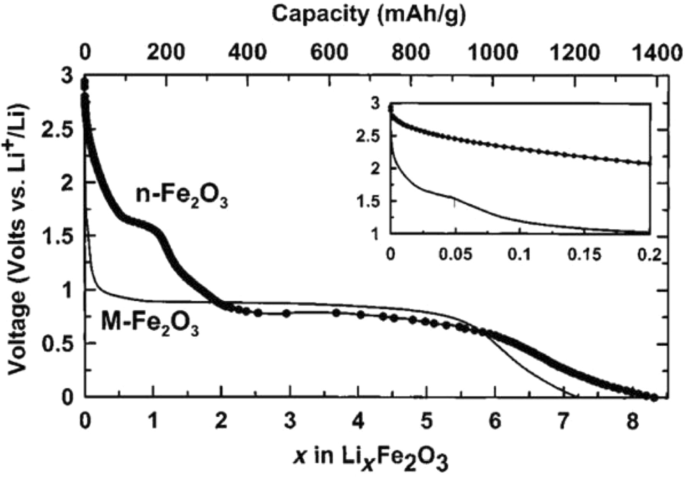
Demonstration of lithium ionization for n -Fe2 O3 and micro-M-Fe2 O3 [80]
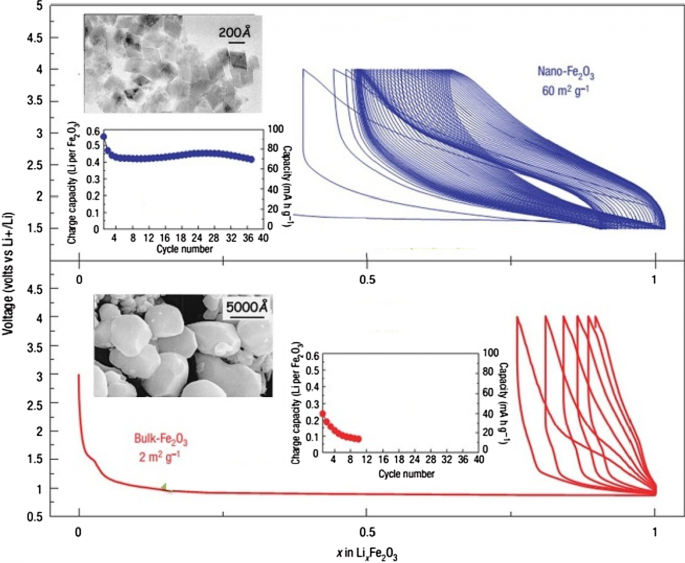
Display of SEM images, charge–discharge curves and cycle life for Nano-iron oxide and bulk [80]
It can be seen from Fig. 26 that at the nanoscale, the cycle life is also much better than bulk. The reason for the improvement of these expressed properties is the ease of volume change and release of stress, ionic and electronic transitions are easier due to the reduction of the penetration distance, which was expressed in this series of articles. Due to high hysteresis, less attention has been paid to compounds with hysteresis [22, 51,52,53,54, 80].
Nanomaterials in Batteries
Nanomaterials have been widely applied in the life sciences, information technology, the environment, and other related fields. Recently, nanostructured materials have also attracted attention for application in energy storage devices, especially for those with high charge/discharge current rates such as lithium ion batteries. The development of next-generation energy storage devices with high power and high energy density is key to the success of electric and hybrid electric vehicles (EVs and HEVs, respectively), which are expected to at least partially replace conventional vehicles and help solve the problems of air pollution and climate change. These energy storage technologies will rely on innovative materials science, i.e. developing electrode materials capable of being charged and discharged at high current rates. Generally, the potential advantages of nanostructured active electrode materials can be summarized as follows:new reactions can be used that are not possible with bulk materials; a larger electrode/electrolyte contact area, leading to higher charge/discharge rates; short path lengths for both electronic and Li ion transport (permitting operation even with low electronic or low Li ion conductivity, or at higher power); etc. Here, we review some recent experimental results that show the advantages of nanostructured active electrode materials [147]. Table 2 summarizes the nanotechnologies that are used to produce nanomaterials, such as mechanical ball milling, chemical vapour deposition, the template method, electrochemical deposition, hydrothermal reaction, dehydration, sintering, pulsed laser deposition, ultrasound, sol–gel synthesis, and micro emulsion.
The first group of applications of nanotechnology in batteries is itself divided into two categories:the first group nanoscale the active substance in the electrode, the second group use nanotechnology to improve the performance of electrodes (cathode or anode) by adding nanomaterials other than the active substance, or the use of Nano coatings. For example, Nano-dimensional additives such as Nano carbons, graphene, carbon nanotubes, etc. have better electron conduction, or the use of Nano-thick coatings on the active material to prevent unwanted reactions with the electrolyte, stress modulation, provide stability and …. for it. For example, for a LiFePO4 cathode, the amount of electron conductivity is poor. Conductivity is improved by using a conductive carbon coating on its particles or by using a conductive carbon material as an additive, A Nano-thick coating of oxide is used [83, 94, 172,173,174,175,176,177]. For example, for a LiFePO4 cathode, the amount of electron conduction is poor, Conductivity is improved by using a conductive carbon coating on its particles or by using a conductive carbon material as an additive, or the LiCoO2 cathode is unstable at high currents in the vicinity of the electrolyte, using a Nano-thick oxide coating to stabilize it [162, 163, 178, 179]. If we want to illustrate the field of nanotechnology in this category with an example, in the same LiFePO4 cathode it has been shown that carbon coating increases conductivity and consequently power, capacity, etc., but one of the areas of research is how to create this coating. Be cheap, effective, etc.; therefore, research in the field of synthesis methods is very important. On the other hand, how to add the same coating and additives to be more effective, so the engineering and architecture of nanostructures is one of the important areas of research and the preparation of these engineered structures is also an interesting issue. Consider Fig. 27 to clarify the matter. This figure shows two types of Nano-engineered structures for the LiFePO4 cathode that use carbon nanotubes to improve conductivity. In addition to differences in performance, each of these structures has a different synthesis method, which indicates the importance of synthesis.
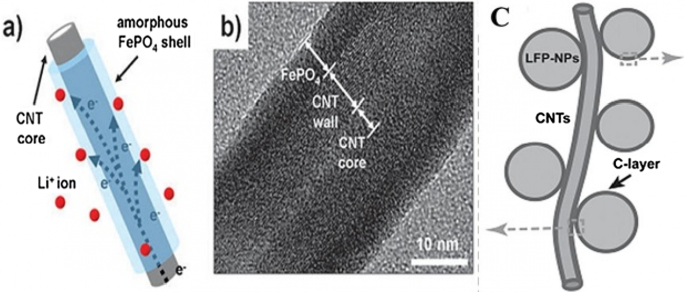
a , b With carbon nanotube core and LiFePO4 wall, and Figure c LiFePO4 nanoparticles attached to carbon nanotube [3, 93]
Silicon has attracted tremendous attentions as one of the most promising candidates for the next-generation Li-ion batteries (LIBs). Compared to the traditional graphite anode, it has many obvious advantages such as large capacity, high abundance and environmental friendliness [1,2,3,4]. Unfortunately, due to the huge volume expansion (~ 300%) in lithiation, silicon particles are pulverized and solid electrolyte interphase (SEI) layers formed on their surface are unstable. Therefore, the long-term cycling stability of silicon anode is poor [5,6,7,8]. Moreover, the low intrinsic conductivity of Si causes unsatisfying rate-capability [9,10,11,12]. Thus, a large amount of Si/metal (e.g., Ag, Cu, Al, Sn) composites have been developed to solve the low conductivity [13,14,15,16]. However, the large volume expansion cannot be relieved effectively. On the other hand, carbon Nano layers are coated on the electrode materials to increase their conductivity, enhance their mechanical strength and provide them stable interfaces with electrolyte. Therefore, various conformal carbon layer coated silicon (Si@C) nanostructures are developed. For example, Si@C with core–shell structure are formed by pyrolyzing various precursors (e.g., pitch, glucose) to coat carbon layers on the pre-prepared silicon nanoparticles [17,18,19,20,21].
Cui et al. designed a hierarchical pomegranate-structured Si@C composite and a nonfilling carbon-coated porous silicon micro particle via the pyrolysis of resorcinol–formaldehyde resin (RF), respectively [23, 82]. And Yu et al. prepared double carbon shells coated Si nanoparticles via chemical vapor deposition (CVD), with acetylene as carbon source [24]. All these designs provide sufficient voids to allow large volume changes of Si during the lithiation/delithiation. However, most of Si@C composites were prepared in separate steps by either pre-coating or post coating carbon on silicon nanomaterials. It led to a complicated preparation strategy.
Continued interest in high performance lithium-ion batteries has driven the development of new electrode materials and their synthesis techniques, often targeting scalable production of high quality nanoceramics (< 100 nm in diameter), which may offer performance improvements. However, there are a number of hurdles, which need to be overcome to move away from current batch synthesis methods that offer poor reproducibility or lack of control over crystallite attributes, particularly at larger scale syntheses. Continuous hydrothermal flow synthesis (CHFS) processes are a promising route for the direct and controlled manufacture of Li-ion battery electrode nanoceramics. Such processes use superheated water and metal salt mixtures as reagents. In a typical CHFS reaction, a feed of supercritical water (above the critical point of water (TC = 374 °C and Pc = 22.1 MPa), is rapidly mixed in an engineered mixer [1] with a metal salt/base aqueous precursor feed (at ambient temperature and the same pressure), resulting in rapid formation of the corresponding nanocrystallite oxide in the water. This nucleation dominated reaction occurs as a result of the metal salts being supersaturated upon mixing with sc-water and also instantly being hydrolysed and dehydrated under these exotic reaction conditions. The nascent nanocrystallite metal oxide stream in water is then cooled in process and then can be constantly collected from the exit of the CHFS process as an aqueous nanoparticle slurry at ambient temperature. The cleaned crystallites (e.g. via dialysis) can be obtained as a wet solid and then freeze-dried to retain maximum surface area and reduce agglomeration. Compared to batch hydrothermal syntheses, CHFS type processes typically produce very small nanoparticles (< 10 nm) with a narrow size distribution [2,3,4]. Additionally, CHFS processes are highly scalable (> 1 kg per hour in the lab of the UCL authors [5]) and can be used to make high quality nanoparticles at scale, with little or no significant variation between those made on the smaller CHFS laboratory scale process.
Cyclic voltammetry (CV) measurements at a scan rate of 0.05 mV s −1 in the range of 0.05–3 V versus Li/Li + , are presented in Fig. 28. A pair of cathodic and anodic peaks were observed in the potential range 1.5 and 2.3 V versus Li/Li + , relating to Li-ion insertion into and extraction from the interstitial octahedral site of TiO2 (see equation) [81]. Under normal circumstances, a two-phase reaction is expected to occur during lithiation with phase equilibrium of the Li-poor Li0.01 TiO2 (tetragonal) phase and the Li-rich Li0.55 TiO2 (orthorhombic) phase [19, 20]. The detected specific current peak decreased with higher amount of Sn, thereby reducing the amount of pure TiO2 。 The pure TiO2 sample showed virtually no electrochemical activity in the potential range between 1.3 and 1 V versus Li/Li + during the first cycle. The increasing specific current during the first cycle between 1 and 0.05 V versus Li/Li + , is attributed to solid electrolyte interface (SEI) formation (electrolyte destruction) at lower potentials [13]. There was also likely to be substantive SEI formation at the crystallite surfaces of the Sn-doped materials compared to the undoped TiO2 , as there was significant electrochemical activity in the range of 1.3 to 1 V versus Li/Li + for the former. However, as the surface area decreases with higher Sn-loading, the initial capacity loss due to the SEI formation may be expected to decrease. The general trend in fact showed that with higher Sn-loading, the initial irreversible capacity loss increased (from 363 mAh g −1 for the pure TiO2 and 467 mAh g −1 for Ti0.85 Sn0.15 O2 ).

Cyclic voltammograms for the 1st and 2nd cycles for the as-prepared Nano-powder in the potential range of 0.05 and 3 V versus Li/Li + for an applied scan rate of 0.05 mV s −1 for a undoped anatase TiO2 , b Ti0.94 Sn0.06 O2 , c Ti0.89 Sn0.11 O2 , and d Ti0.85 Sn0.15 O2 。 e Specific current versus potential of the 2nd cycle for all materials at lower potentials. The specific current was calculated by taking into account the active material mass loadings [81]
Conclusion
- 1.
This article discusses silicon anodes as a representative of alloy anodes. It was observed that the only solution to solve the shredding problem is to use nanotechnology. In this paper, the importance of nanomaterial synthesis was expressed. In summary, how to use nanomaterials with different morphologies to solve the problem and improve power. Although various morphologies were discussed, there was no discussion of structural engineering and the use of carbon conductive materials, which will be discussed in future articles. This was one of the methods of establishing electrical bonding for nanoparticles. There are various structures to prevent the nanoparticles from breaking, the art of which is to create different geometries and the method of their preparation.
- 2.
This article discusses SEI, which is one of the most important topics in most anodes and some high voltage cathodes. This article discussed the problem of alloy anode fragmentation, while which is due to the continuous growth of SEI. It turned out that in order to have a proper cycle life, this problem must be overcome. According to the given examples, using a suitable design at the nanoscale, in addition to providing free volume change of silicon, this volume change does not occur in contact with the electrolyte.
- 3.
The carbon coating on the anode can increase the conductivity from 13–110 to 2.05 S/cm. Doping can enhance performance by increasing the conductivity of electrons and even ions and providing more space within the network along with Nano sizing, which may be appropriate for new projects, which is more a Nano-topic in Nano synthesis than how it accompanies matter. Synthesize with Nano-dimensional doping until there is a discussion about the effect of Nano on improving anode performance. This article discusses titanium oxide anodes, which is one of the most commercially important anodes. It was found that nanotechnology greatly improves the performance of these anodes. Nano sizing has also been shown to affect even the electrochemical and chemical-physical nature (such as charge–discharge curve deformation and greater capacity in surface layers).
- 4.
In this paper, exchange anodes are introduced and their complex operation is described. It was found that many problems, such as alloy anodes, can be solved by Nano damaging the active material. The special effects of Nano were expressed as a change in mechanism.
Availability of Data and Materials
All data generated or analyzed during this study are included in this published article.
ナノマテリアル
- R、X、およびZのレビュー(抵抗、リアクタンス、およびインピーダンス)
- 信頼性とリーンプログラムパワーエナジャイザーバッテリープラント
- 将来のバッテリーのためのスズナノ結晶
- 農業生態系におけるバイオセンサーとナノセンサーの応用に関するレビュー
- スーパーキャパシター用途向けのグラフェンおよびポリマー複合材料:レビュー
- 多孔質および中空構造のLiNb3O8アノード材料に向けた熱水支援焼結戦略
- リチウムイオン電池の高性能アノードの前駆体としての酸素内方拡散によるスラッジSiのナノSi / SiOx構造への変換
- レビュー:油水分離用の多孔質金属フィルターと膜
- リチウムイオン電池アノード用の赤色リンナノ粒子の容易な溶液合成
- リチウム電池が鉛蓄電池よりも優れている4つの理由
- ロボットとバッテリー製造:積極的なつながり



